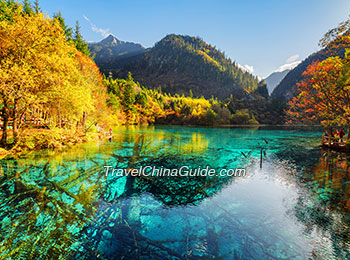
Why is it Called Five Flower Lake?
Nestled amidst the vibrant tapestry of Jiuzhaigou Valley in China, Five Flower Lake stands as a testament to nature's artistry. Its name, evocative of a painter's palette, hints at the mesmerizing spectacle that unfolds upon its surface.
A Kaleidoscope of Colors
The lake's most captivating feature is its namesake – the five distinct colors that dance upon its crystal-clear waters. This mesmerizing phenomenon is a result of a delicate interplay of natural elements:
- **Calcium Carbonate:** The water is richly infused with calcium carbonate, a mineral known for its reflective properties. This mineral acts as a prism, scattering sunlight into a spectrum of colors.
- **Hydrophytes:** A vibrant underwater garden of hydrophytes further enhances the chromatic display. These aquatic plants, each species boasting its unique pigmentation, contribute shades of azure blue, emerald green, and even a touch of crimson to the water's canvas.
- **Sunlight:** The angle of the sun also plays a crucial role. As sunlight pierces the water's surface, it interacts with the calcium carbonate and hydrophytes, illuminating them with varying intensities and creating a breathtaking mosaic of hues.
The following table summarizes the contributing factors to Five Flower Lake's colors:
| Factor | Description | Color Contribution |
|---|---|---|
| Calcium Carbonate | Reflects and scatters sunlight | Creates a base of brilliant blue and turquoise |
| Hydrophytes | Different species possess unique pigments | Adds shades of green, yellow, orange, and even red |
| Sunlight Angle | Influences the intensity of light hitting the water and plants | Highlights specific colors at different times of day |
A Lake Shrouded in Legend
Beyond its visual splendor, Five Flower Lake holds a special place in the hearts of the local people. It is revered as a holy lake, its existence intertwined with ancient tales and folklore.
Legend has it that the lake is a gift from the mountain deity, a symbol of prosperity and harmony. The five colors are said to represent the five elements of Chinese philosophy – wood, fire, earth, metal, and water – their harmonious coexistence reflected in the lake's serene beauty.
This deep-rooted reverence for Five Flower Lake is evident in the local belief that "where there is the water, there must be flourishing flowers and trees." The lake's pristine environment, teeming with life, stands as a testament to this belief, further solidifying its status as a sacred natural wonder.
FAQs
1. What time of year is best to see the five colors of the lake?
The colors of Five Flower Lake are most vibrant in the autumn, from September to November. During this time, the hydrophytes change color, adding even more depth and variety to the lake's palette.
2. Can you swim in Five Flower Lake?
To protect its fragile ecosystem, swimming is strictly prohibited in Five Flower Lake. Visitors can admire its beauty from designated viewing platforms and trails surrounding the lake.
3. What other attractions are near Five Flower Lake?
Five Flower Lake is just one of many scenic wonders in Jiuzhaigou National Park. Other popular attractions include the Nuorilang Waterfall, Panda Lake, and the multi-tiered lakes of Shuzheng Valley.